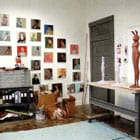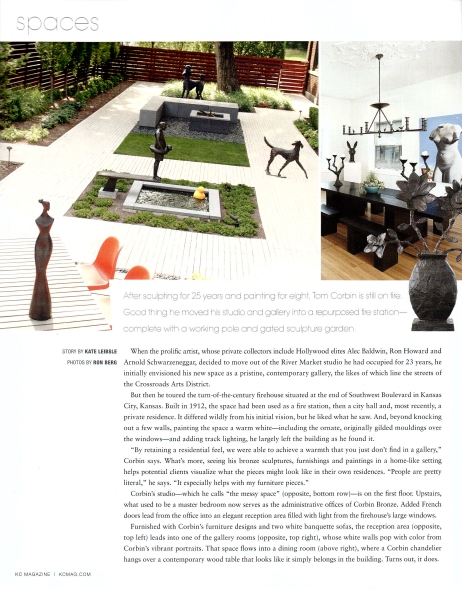After sculpting for 25 years and painting for eight, Tom Corbin is still on fire. Good thing he moved his studio and gallery into a repurposed fire station—complete with a working pole and gated sculpture garden.
KC Magazine
May 2011
Text by Kate Leibsle
Photography by Ron Berg and Corbin Studio
When the prolific artist, whose private collectors include Hollywood elites Alec Baldwin, Ron Howard and Arnold Schwarzenegger, decided to move out of the River Market studio he had occupied for 23 years, he initially envisioned his new space as a pristine, contemporary gallery, the likes of which line the streets of the Crossroads Arts District.
But then he toured the turn-of-the-century firehouse situated at the end of Southwest Boulevard in Kansas City, Kansas. Built in 1912, the space had been used as a fire station, then a city hall and, most recently, a private residence. It differed wildly from his initial vision, but he liked what he saw. And, beyond knocking out a few walls, painting the space a warm white—including the ornate, originally gilded mouldings over the windows–and adding track lighting, he largely left the building as he found it.
“By retaining a residential feel, we were able to achieve a warmth that you just don’t find in a gallery,” Corbin says. What’s more, seeing his bronze sculptures, furnishings and paintings in a home-like setting helps potential clients visualize what the pieces might look like in their own residences. “People are pretty literal,” he says. “It especially helps with my furniture pieces.”
Corbin’s studio—which he calls “the messy space” (opposite, bottom row)—is on the first floor. Upstairs, what used to be a master bedroom now serves as the administrative offices of Corbin Bronze. Added French doors lead from the office into an elegant reception area filled with light from the firehouse’s large windows.
Furnished with Corbin’s furniture designs and two white banquette sofas, the reception area (opposite, top left) leads into one of the gallery rooms (opposite, top right), whose white walls pop with color from Corbin’s vibrant portraits. That space flows into a dining room (above right), where a Corbin chandelier hangs over a contemporary wood table that looks like it simply belongs in the building. Turns out, it does.
“When we moved in, we found huge planks of wood in the basement, and they all had handles, “ Corbin says. “We couldn’t figure out what they were for, until finally we realized that they were used as barriers in front of the firehouse doors during floods.”
Corbin took the planks to fellow artisan Dave Polivka (258 W. Third St.), who planed them and transformed them into the dining room’s table and matching benches.
Just off the dining room is the kitchen, which was designed by the building’s previous owners; it comes in handy during private events or when Corbin donates his space to nonprofits. Two Corbin light fixtures—the only thing the artist changed in this room—hang from the barrel-vaulted ceiling.
Exposed brick walls and beautiful hardwood floors with fanciful black inlay stretch throughout all the rooms. It all makes a striking backdrop for Corbin’s work. “With the new space, I found new direction [for my sculpture],” the artist says. “I’ve started getting away from the human figure and doing some floral and more organic sculpture [opposite, inset].”
The human figures Corbin does produce these days differ wildly from those for which he is most well known. From a tabletop sculpture of a girl pushing a lawnmower (a subject inspired by one of Corbin’s paintings) to an irreverent figure of a woman in a bikini topped with a bunny head (a spoof on celebrity inspired by ancient Egyptian hieroglyphics), it’s clear that Corbin is enjoying his newfound freedom.
He created one of his most playful pieces specifically for his sculpture garden (opposite, left), which lies just beyond his studio. The work depicts a rotund fellow perched on a diving board with an innertube around his ample middle. Appropriately, the sculpture sits just above the garden’s water feature.
The garden is the perfect combination of contemplative and recreational space, thanks to restrained vegetation, well-placed sculptures, a fire pit and a simple table paired with colorful modern chairs. It’s a perfect retreat for Corbin who, when not working on a new piece, is busy taking painting and drawing classes (one wall of his studio is lined with portraits from one such class, bottom left—each must be completed in an hour) or visiting one of the 20 domestic and two international showrooms and galleries that display his work.
It’s a busy life, but it’s one that this onetime advertising executive and longtime artist relishes. “After 25 years, I feel like I have freedom to do what I want,” Corbin says. Fortunately for Kansas City, he has chosen to exercise that freedom here.



